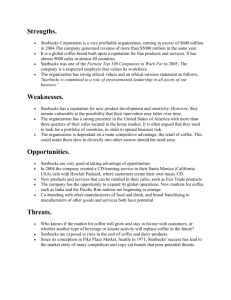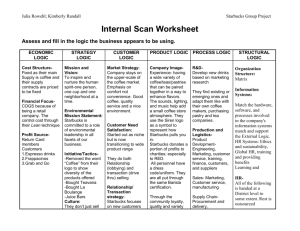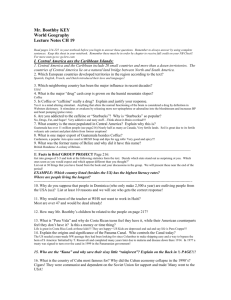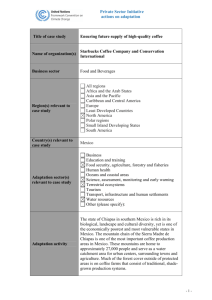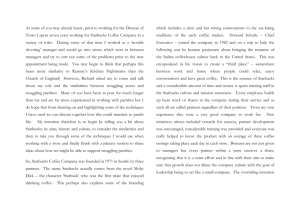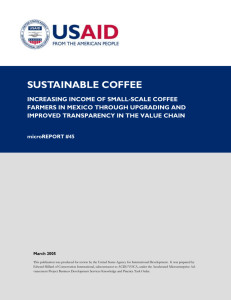Building value chain efficiency with a global company: the case of
advertisement
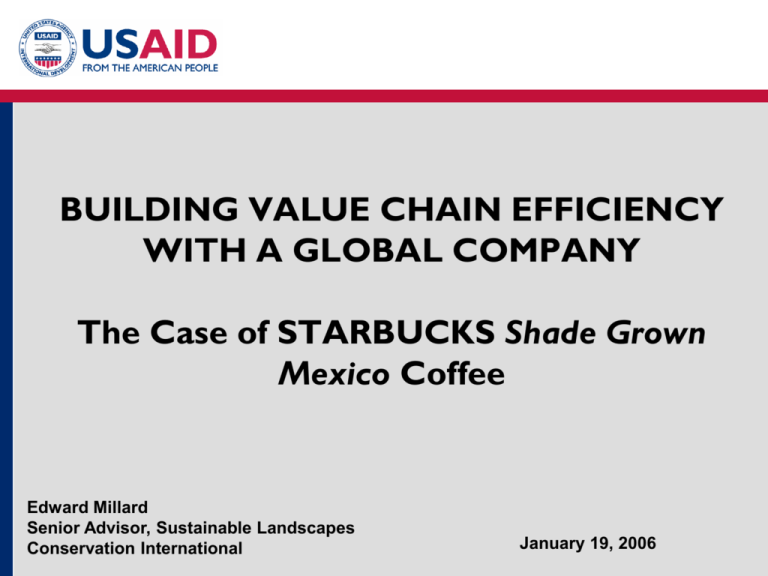
BUILDING VALUE CHAIN EFFICIENCY WITH A GLOBAL COMPANY The Case of STARBUCKS Shade Grown Mexico Coffee Edward Millard Senior Advisor, Sustainable Landscapes Conservation International January 19, 2006 PRESENTATION OVERVIEW 1. The Partnership between Starbucks, Conservation International and Chiapas Coffee Farmers 2. Value Chain Analysis 3. Interventions and Results 4. Impacts - Power - Learning - Benefits - Scaling Up 1. THE PARTNERSHIP: OBJECTIVES Create social and environmental sustainability in Starbucks supply chain Improve benefits for Chiapas coffee farmers Conserve natural resources Learn what works and apply learning to other regions 1.THE PARTNERSHIP: CONTEXT 73,000 smallholders producing one third of Mexico’s coffee Live close to poverty line Coffee only source of cash income Project focused on farms located near to protected areas 2.VALUE CHAIN ANALYSIS: INDUSTRY STRUCTURE International Market Importers / Roasters Quality Testing, roasting and sale Importing, Roasting and Packing Exporters Purchase of coffee or fulfillment of export service contract Payment and Export Quality testing and milling Extension Service Providers Processors Quality Control and Milling Weighing and storage of parchment coffee. Training and Evaluation Producers Financial Services Institutions Credit to farmers Production and Processing Production and first stage processing by cooperatives Training and evaluation of Conservation Coffee Best Practices Credit and government subsidies 2. VALUE CHAIN ANALYSIS CONSTRAINTS End Markets Low price; no market presence Enabling Environment Entrepreneurial under-development Horizontal Linkages Cooperatives lack buying capacity Vertical Linkages Mistrust between cooperatives and traders Supporting Markets Few service providers Firm Level Upgrading Farmers inexperienced in business Power Farmers unable to control main factors affecting their income Learning Concept of Conservation Coffee new Benefits Low price + little power = low income 2. VALUE CHAIN ANALYSIS OPPORTUNITIES End Markets Growth of specialty coffee market Enabling Environment Interest of reserve authorities Horizontal Linkages Investment to strengthen cooperatives Vertical Linkages Market power of lead firm Supporting Markets Firm Level Upgrading Power Learning Benefits Partners committed to sharing learning 3. INTERVENTIONS AND RESULTS End Markets Brand growth: 1998 2000 2002 2 containers 14 containers 44 containers Starbucks designed sustainability program to leverage impact in its supply chain Starbucks committed to buy 60% of all its coffee under C.A.F.E. Practices by 2007 3. INTERVENTIONS AND RESULTS Inter-firm cooperation- Horizontal Linkages Tradition of cooperatives in Chiapas Cooperatives inefficient: members dispersed, officers rotated CI unable to strengthen cooperatives sufficiently 3. INTERVENTIONS AND RESULTS Inter-firm cooperation- Vertical Linkages 2003: Starbucks asked cooperatives to export through AMSA Purchasing contracts stated prices paid throughout value chain In 2003/4 harvest, farmers earned more selling through AMSA Extract from Purchasing Contract … Precio de compraventa Venta Starbucks (cts/lb) Costo Amsa (usd/qq) Costo Amsa (cts/lb) Precio Compra (cts/lb) Precio Compra (usd/kg) EX Works Tuxtla certificado orgánico A B C D= A-C E 143 25,25 24,90 118,10 2,60 3. INTERVENTIONS AND RESULTS Supporting Markets – Sector Specific BDS Independent extension agents certified by Secretary of Education Fee paying system introduced for technical assistance Starbucks opened Farmer Support Center 2003 3. INTERVENTIONS AND RESULTS Supporting Markets- Financial Services CI partnered with Ecologic 2001 to begin credit fund Starbucks invested $2.5 million for coffee credit US$2 million invested - 99% repaid 4. IMPACTS: POWER Transparency: introduced in value chain by lead firm Trust: built by inter-firm linkages Innovation: farmers owned product attributes 4. IMPACTS: LEARNING Farmers gained access to information, technology and capital from Starbucks, CI and local partners Starbucks provided market, support services and knowledge for upgrading CI provided technical innovation and trained partner firms End market growth enabled Starbucks to drive incentives through value chain 4. IMPACTS: BENEFITS Household indicators improved Local service providers entered market Environmental management practiced Natural resources conserved 4. IMPACTS: SCALING UP 5,000 farmers in six countries Reaching new markets Strengthening USAID partnership CONCLUSION THANK YOU! Please visit www.microlinks.org/breakfast for seminar presentations and papers Edward Millard e.millard@conservation.org January 19, 2006
